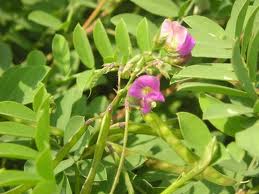| PlantID | 0123 |
| Botanical Name | Tephrosia purpurea |
| Common Name | Sarphonka |
| Classification | | Kingdom: | Plantae | | Subkingdom: | Tracheobionta | | Division: | Magnoliophyta | | Class: | Magnoliopsida | | Subclass: | Rosidae | | Order: | Fabales | | Family: | Fabaceae | | Genus: | Tephrosia | | Species: | purpurea |
|
| Part used | Whole plant, seeds, root-bark and root |
| Medicinal Properties | Laxative, anthelmintic, infusion, astringent, acrid, thermogenic, alexiteric and antipyretic.
|
| Medicinal Use | Roots : useful in inflammations, skin diseases, scrofula, elephantiasis, dyspepsia, stomachalgia, flatulence, haemorrhoea, chronic fever, boils pimples, haemorrhoids, asthma, bronchitis, anaemia, hepatosplenomegaly, verminosis, strangury, odontalgia and gingivitis. Leaves: useful in dyspesia, pectrol diseases, syphilis, gonorrhoea and bruises. Seeds: useful in skin diseases and rat poisoning. Seeds: used against worm infection in children. Oil: recommended for external application in scabies and dermatosis. Bark: pounded with black pepper employed in refractory cholic.
|
| Chemistry | Beta-Sitosterol, lupeol, retin, delphinidin chloride, cyaniding chloride, isolonchocarpin, lanceolatins A and B, pongamol, karangin, kangone, 5,7-dimethoxy-8, flavanone, 2-methoxy-3-9-dihydroxycoumestone, flevichapparins B and C, methyl karanjic acid and purpurin. |
| Cultivation | NA |
| Regional Habitat | Throughout Rajasthan, on waster lands and along roadsides. |
| Description | A suberect, much-branched, polymorphic, perennial herb, 30-60 cm in height. Leaves: impairipinnate, 5-15 cm long. Leaflets: 9-21, glabrous above and obscurely silky beneath, narrow, oblanceolate. Flowers: borne in leaf-opposed racemes, blue or purple. Pods: linear, slightly curved, glabrescent. Seeds: 5-10, smooth, greenish-grey. |
| Image |  |


